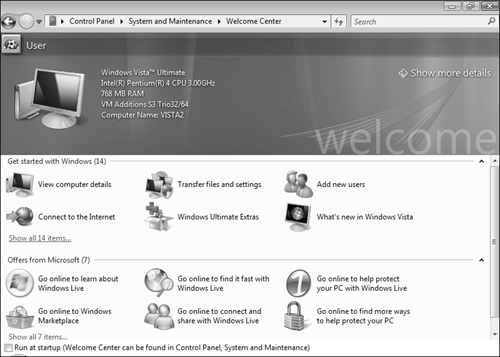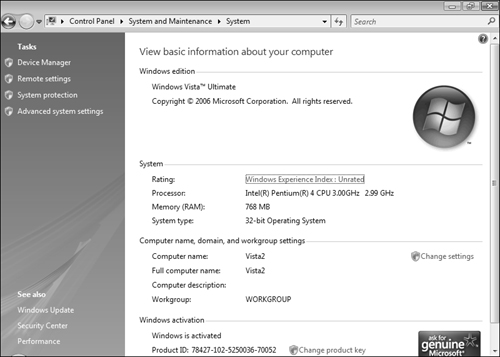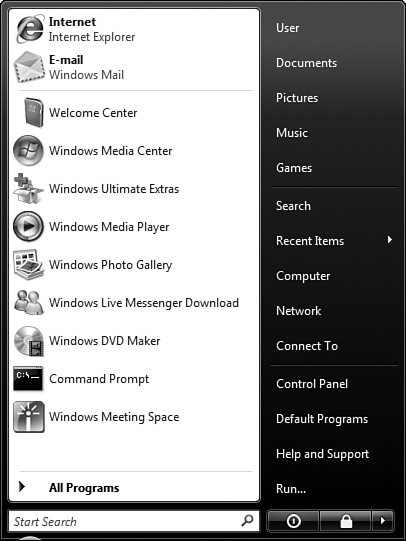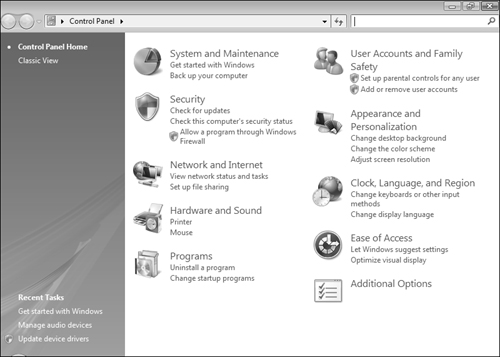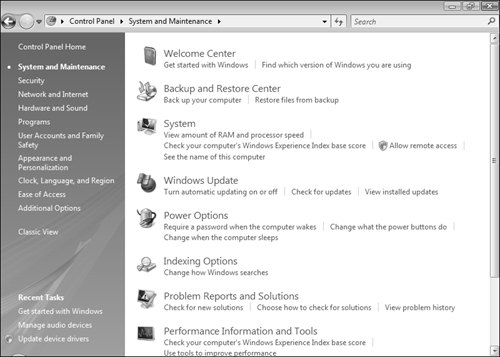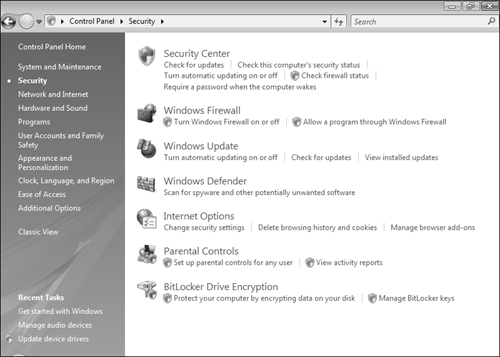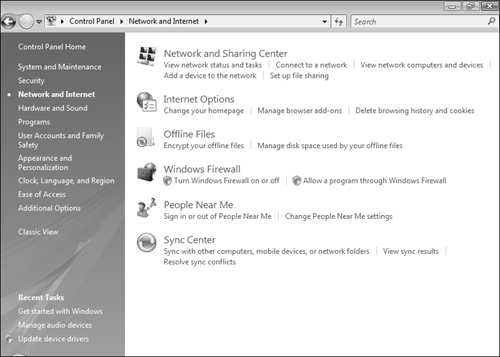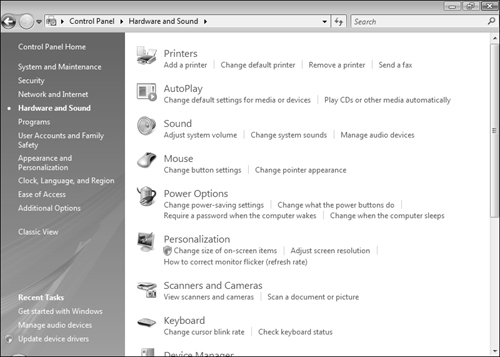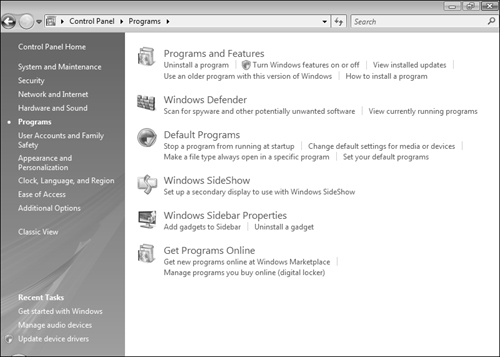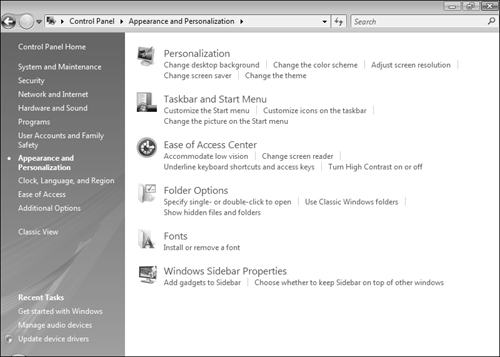In the years since it was first released, Windows XP has become nearly ubiquitous throughout the homes and offices of PC users worldwide. Although it’s a very stable, easily used operating system, it has become plagued with security problems in recent years. Service Pack 2 (SP2) certainly helped overcome these problems, but a new upgrade to the operating system, which has been in the works for several years, was sorely needed to overcome security problems and provide an enhanced productivity environment for home and business users alike.
This study guide begins by looking at what Windows Vista is and explaining its features and concepts in a manner that sets the stage for the coming chapters. This chapter does not contain any formal Microsoft exam objectives, but you should become familiar with the terms introduced here. This information guides you as you study how to configure and secure Windows Vista in the many situations that arise in the world of everyday desktop support.
Outline
Windows Vista represents the first upgrade in more than five years to the flagship Microsoft Windows operating system. More than four years in the making, Windows Vista includes versions intended for business use as well as use on home computers of various types of configuration. The Microsoft 70-620 Exam assesses your ability to install, configure, administer, and troubleshoot Windows Vista and focuses on how to do so in a business environment. Before discussing the exam topics in detail, this chapter presents an overview of the new features of Vista and sets the stage for the chapters to come.
Microsoft designed Windows Vista for both home and business users. Vista provides a 32-bit operating system based on the Windows NT (and later, Windows 2000 and Windows XP) kernel, including new desktop graphics, easy-to-follow menus, and enhanced personalization options. Also included are enhanced networking features that enable simplified connection to wired and wireless networks, enhanced user management, and improved security policies.
The PC has transformed over the past quarter century from a standalone computer that performed little more than word processing and spreadsheet functions to a portable multimedia machine supporting a diverse set of applications. Microsoft has been at the forefront of this development, providing the most ubiquitous operating system to power PC applications—Windows.
Microsoft first announced its new graphical operating environment named Windows 1.0 on November 10, 1983, and then released it in 1985. Windows 2.0 followed in 1987. Those early versions of Windows were hardly memorable; however, most people remember Windows 3.0 (released in 1990) because of its wide popularity. Microsoft began integrating peer-to-peer and domain networking support in Windows for Workgroups 3.11, released in 1993.
At that time, Microsoft was working with IBM to build a new industrial-strength networking system based on IBM’s popular OS/2 operating system. Plans were made to create a new operating system to be called OS/2 NT. Microsoft wanted to build on its accomplishments with Windows 3.x, but IBM wanted to continue with OS/2. Thus the partnership broke up, and Microsoft retained the rights to further Windows developments. Consequently, Microsoft introduced 32-bit networking in the form of Windows NT 3.1. NT stands for “New Technology,” and 3.1 referred to the fact that the interface resembled Windows 3.0.
From the point that Windows NT was introduced, Microsoft split its operating systems into three basic groups: home user versions, corporate user versions, and server versions. The home user versions grew from Windows 3.x to Windows 95 (released in August 1995) to Windows 98 and Windows Millennium Edition (Me). At this point, Microsoft brought the home and corporate user versions together under the Windows NT kernel. The home user version became Windows XP Home Edition.
The corporate user versions were Windows NT 3.1; Windows NT Workstation 3.5 (released in 1994); Windows NT Workstation 3.51 (released in 1994); Windows NT Workstation 4.0 (released in 1996), which had the new interface matching Windows 95; Windows 2000 Professional; and Windows XP Professional. Microsoft also added a complete entertainment software package to Windows XP Professional, including support for watching and recording TV shows and working with digital music and videos, to create the Windows XP Media Center Edition.
Almost as soon as Microsoft introduced Windows XP, it publicly announced initial plans for the next release of Windows, which it code-named “Longhorn” and originally planned to release in 2003. Within months, this date was pushed back to at least 2004. Around this time, Microsoft was putting together SP2 for Windows XP with its new security initiatives. This push for enhanced security resulted in a significant slowdown on the development of Longhorn until the completion of XP SP2. Consequently, in 2004 Microsoft announced that it was targeting Longhorn’s release for 2006 and revealed that Longhorn would incorporate major security enhancements beyond that of XP SP2, including technologies that would improve the resistance to such attack vectors as viruses, spyware, and other forms of malicious software. And in July 2005, Microsoft announced that the client version of Longhorn would be named “Vista,” and this set the stage for the final push to completion. But yet again, in 2006, Microsoft pushed the final release of Vista back into 2007, announcing that corporate versions would be available in November 2006, and the final public release was set for January 30, 2007.
With the development of the new Windows operating system, Microsoft introduced two home versions—Windows Vista Home Basic and Windows Vista Home Premium. Windows Vista Business and Windows Vista Enterprise are the successors to Windows XP Professional, and Windows Vista Ultimate combines the features of both Windows Vista Enterprise and Windows Vista Home Premium into one operating system.
The server versions all were based on the 32-bit Windows NT kernel and released at roughly the same times as the workstation versions—Windows NT 3.5 Server, Windows NT 4.0 Server, and Windows 2000 Server. Windows Server 2003 was introduced roughly one and a half years after Windows XP made its debut. Each server release also had additional server versions that provided additional services and/or hardware support for high-end corporate uses. Microsoft is currently working on a new version of its server, which will be known as Windows Server 2008 and will be released in early 2008.
Today’s Windows Vista represents more than 50 million lines of code and more than 20 years of research and development since the earliest versions of Windows.
Microsoft designed five major editions of Windows Vista, each suited for a different segment of the general population: Windows Vista Home Basic, Windows Vista Home Premium, Windows Vista Business, Windows Vista Enterprise, and Windows Vista Ultimate. Table 1.1 compares the editions of Windows Vista and compares the basic features available with each.
Table 1.1. Windows Vista Editions
Edition | Designed for | Notable Features |
|---|---|---|
Home Basic | Home users who need only basic computing capabilities | Fundamental security capabilities such as Internet Explorer 7 and Windows Defender, as well as Windows Mail and parental controls |
Home Premium | Enhanced home usage capability, including music, photo, and video usage | 3D Aero desktop, photo and video handling and basic editing, DVD authoring, Mobility Center, and Windows Media Center |
Business | Business users who need only basic computing capabilities | Windows Meeting Space, domain membership, advanced backup capabilities including shadow copy, business networking capabilities, and Remote Desktop |
Enterprise | Business users who need advanced computing and security functions | BitLocker drive encryption and MultiLanguage User Interface (MUI) |
Ultimate | Home and business users who desire the complete experience | All features included with Vista Home Premium and Vista Enterprise |
In addition, Microsoft includes a Starter Edition that provides only very fundamental computing capabilities and is designed only for selected markets in developing overseas countries. This edition was created to address the issue of software piracy that has been rampant in these markets, as well as their financial and emerging market concerns. To meet the regulatory concerns of the European Union, Microsoft also includes “N” versions of these editions, which include all features except media-related capabilities.
Table 1.2 provides additional detail on the components included in the various editions of Windows Vista. Many of these features are introduced in the following sections.
Table 1.2. Components Included in Vista Editions
Home Basic | Home Premium | Business | Enterprise | Ultimate | |
|---|---|---|---|---|---|
Internet Explorer 7 | x | x | x | x | x |
Instant Search | x | x | x | x | x |
Windows Mail | x | x | x | x | x |
Windows Defender | x | x | x | x | x |
Windows Firewall and Security Center | x | x | x | x | x |
Parental Controls | x | x | x | x | x |
Windows Media Player | x | x | x | x | x |
Windows Aero and Aero Glass | x | x | x | x | |
Windows Media Center/Movie Maker/DVD Maker | x | x | |||
Windows Collaboration | x | x | x | x | |
Advanced networking capabilities | x | x | x | x | |
Windows Mobility Center/Tablet PC support | x | x | x | x | |
Scheduled backups | x | x | x | x | |
Domain support | x | x | x | ||
Complete PC Backup and Restore | x | x | x | ||
File encryption using Encrypting File System (EFS) | x | x | x | ||
Remote Desktop | x | x | x | ||
Windows Web Server | x | x | x | ||
BitLocker drive encryption | x | x | |||
Multilanguage User Interface (MUI) | x | x | |||
Subsystem for UNIX-based applications | x | x | |||
Secure Startup | x | x |
As can be expected from the more than five-year interval between the introduction of Windows XP and Windows Vista, there are a large number of new features included with Windows Vista. Every edition of Windows Vista includes the same basic features. Additional features appear in some editions of Vista but not in others. The lists that follow are not designed to be exhaustive; they merely introduce the most important new features included with Windows Vista.
Windows Vista includes a number of new features and enhancements that are designed to improve the way users interact with the computer. The basic productivity enhancements included with every edition of Vista include the following:
Improved user interface and Start menu—. The new look to the user interface includes translucent window borders and a new Windows Sidebar on the right side of the desktop. While similar to the Windows XP Start menu, the Vista Start menu includes a new instant search assistant that directs you to any program or file on your computer (including multiple locations such as email, the Windows Calendar, HTML pages from the browser cache, and so on), network, or the Internet. You learn about the Start menu in more detail later in this chapter.
Aero Glass—. Available on all Vista editions except Home Basic, this is the new desktop appearance featuring translucent title bars that reveal objects hidden beneath them. You can also hover your mouse pointer over taskbar buttons to reveal live thumbnails of the document or program to which the button relates. Pressing the Windows+Tab key combination reveals live windows of each open document in sequence, facilitating your selection of the correct one. You can configure all these features from the Display applet in Control Panel.
Windows Mail—. This standard email application replaces Outlook Express and includes a new search capability. It also includes a junk mail filter patterned after the one in Outlook, as well as a phishing filter that alerts you when an email is attempting to send you to a bogus website that intends to extract personal information such as bank account or credit card numbers.
Improved startup capabilities—. Microsoft has improved the startup code so that initialization scripts and applications can complete their tasks in the background and the user is able to begin work much sooner.
Sleep mode—. Combining features of Windows XP’s Standby and Hibernation modes, Sleep mode enables you to preserve open documents and programs on shutdown, enabling you to resume work rapidly from where you left off.
Restart Manager—. Facilitates the installation of updates and patches by keeping track of running processes and shutting down only the essential processes during patching. This reduces the need for rebooting your computer after installing updates and patches.
Windows Experience Index—. This is a performance scoring metric that assesses the capability of several hardware and software components on your computer. It includes such components as the processor, memory, graphics card, and hard disk and displays a base score that relates to the weakest performing component on your computer. Thus it suggests which component you should upgrade to improve your computer’s overall performance.
Improved stability factors—. Vista adds features such as input/output (I/O) cancellation, which detects when a program is unable to receive input from an unavailable resource and cancels the invalid request. Service recovery policies enable Vista to restart failed essential services and reset dependent services, thereby reducing the need for reboots following service failures. A startup repair tool automatically diagnoses and repairs many startup problems.
Improved hardware diagnostics—. Vista includes improved diagnostic tools that monitor crashes caused by problems such as disk or memory failures. Network diagnostics monitor network connections and either fix problems or inform the user of ways she can remedy the problem. The Windows Diagnostic Console improves upon the Windows XP Performance Console to provide enhanced performance statistics.
Support for document metadata—. Vista can search for documents, pictures, and so on with the aid of metadata included with many file types—that is, data about data. The Search service indexes many types of metadata and enables you to filter search results to view data that contains specific property values. For example, you can filter images to display only those taken with a specific camera within a specified block of time.
Later chapters of this book discuss specific details about many of these features. For additional information, consult the references provided in the “Suggested Readings and Resources” section at the end of this chapter.
As you know, Windows XP and other Windows versions have been subjected to a never-ending flow of new vulnerabilities. Microsoft has introduced several new features designed to improve the security of computing in Vista:
Secure Startup—. This feature prevents unauthorized users from accessing sensitive data during startup by encrypting the system drive. It utilizes a hardware module called the Trusted Platform Module (TPM), which is found on many recently manufactured computers.
User Account Control—. All users, even administrators, operate in a limited mode that prevents actions that may be detrimental to system security. When users need to perform potentially risky tasks, Vista presents a dialog box requesting permission or credentials to perform the task. This feature helps to prevent actions attempted by malicious users or software.
Improvements to Windows Firewall—. Windows Firewall now blocks both incoming and outgoing traffic unless specifically configured to pass. This can block actions by malicious programs such as Trojan horses that attempt to send data to an unauthorized location.
Windows Defender—. Introduced in Windows XP as Windows AntiSpyware, Windows Defender monitors your computer for signs of spyware infection and blocks actions of malicious programs, such as their installation.
Spam and Phishing Filters—. Windows Mail includes an antispam filter that scans incoming messages for features prevalent in spam messages. A phishing filter alerts you when a message attempts to extract personal information.
Network Access Protection—. This is a service that checks the security status of a computer and compares the results to a set of network guidelines installed on a server that supports the feature. If the computer is not completely up-to-date with respect to security features such as patches or virus signatures, it is restricted to a protected area of the network from which it can download and install the required products.
Parental controls—. These controls enable parents to set limits on their children’s activities by blocking access to specific types of websites or folders, specific content categories such as pornography, and file downloads; setting time limits; restricting games; and so on.
Windows Service Hardening—. Vista limits the damage that can be caused by a compromised service. It runs services at a lower privilege level and provides only the permissions required by the service to perform its functions. Services are restricted so that they can only perform their intended activities.
Chapter 4, “Configuring and Troubleshooting Post-Installation System Settings” and Chapter 5, “Configuring Windows Security Features,” provide details of most of these features.
Microsoft has packaged a basic set of programs and tools with every edition of Windows Vista. The following items highlight the most significant new programs and tools:
Welcome Center—. This application starts automatically when you first start your computer and log on. It displays your Vista edition and activation status and provides links to basic tasks such as adding printers, personalizing your experience, adding users, and installing devices. You can also access the Control Panel and view your hardware and Windows settings. You learn more about the Welcome Center later in this chapter in the section, “A Quick Tour of Windows Vista.”
Windows Easy Transfer—. This is an update to the Files and Settings Transfer Wizard that was introduced in Windows XP. It supports additional media types such as flash drives.
Internet Explorer 7—. Microsoft has added tabbed browsing, in which you can have multiple open pages available in their own tabs within a single Internet Explorer window. Internet Explorer 7 also features a new Manage Add-ons dialog box, which enables you to enable or disable add-ons and delete unwanted ActiveX controls, as well as an improved browsing history deletion feature and support for Real Simple Syndication (RSS) feeds.
Windows Mail—. We have already mentioned this successor to Outlook Express. This application also includes a preconfigured account for Microsoft’s newsgroup server, msnews.microsoft.com, which includes help groups designed to provide the best computing experience for Vista users.
Windows Calendar—. This application enables you to track appointments, provide reminders, schedule tasks, and view appointments by the day, week, or month. You can also set up multiple calendars for different users or purposes.
Windows Media Player 11—. This major update includes several new features, such as a cleaner interface that can include downloaded album art. It allows several views based on media metadata, an advanced metadata editor, an improved Search box, a capability for synching with compatible media devices, easier ripping of audio CD tracks, additional options for burning to media discs, DVD playback, and several other features.
Media Center—. Included with Vista Home Premium and Vista Ultimate, the Media Center comes with an improved interface and menu structure.
Windows Photo Gallery—. This application facilitates the downloading of images and videos from cameras, scanners, and network or Internet sources. You can view images, edit their metadata, and apply simple fixes to photos.
DVD Burning—. Vista enables you to burn DVDs from several places such as Windows Media Player, Media Center, and Windows Photo Gallery. This eliminates the need for third-party applications, as was the case in Windows XP.
Windows Mobility Center—. On laptops and other mobile computers, you can view and configure features such as battery status, wireless network connections, offline file synchronization, screen brightness, and so on. On a Tablet PC you can also control screen orientation.
Network Center and Network Map—. Enables you to configure your network connection and displays network components to which your computer is connected.
Windows Collaboration—. This is an update to the NetMeeting program in Windows XP. It enables you to show data to multiple users and collaborate on documents. You can invite people from various sources and do presentations.
Control Panel improvements—. Microsoft has added new categories and modified existing ones compared to those provided with Windows XP. Each category provides links to specific features, and some applets are cross-referenced to more than one category. Links to recent tasks are also included.
Chapter 6, “Configuring Network Connectivity,” and Chapter 7, “Configuring Applications Included with Windows Vista,” discuss these programs and features in detail.
Windows Vista builds on the visual experiences introduced with Windows XP to offer you a whole new computing experience. This section introduces many of the new features you will become familiar with as you begin to work with Microsoft’s latest operating system.
When you first log on to a new installation of Vista, the Welcome Center shown in Figure 1.1 automatically starts and provides insight into many of the new features of Vista as well as several features updated from your Windows XP versions.
The Welcome Center automatically starts each time you log on until you clear the check box labeled Run at Startup, found at the bottom of the screen. If you want to run the Welcome Center later, go to the System and Maintenance category in Control Panel. Note that the items available from the Welcome Center may depend on the edition of Vista you are running. The following is an introduction to several items accessed from the Welcome Center:
View Computer Details—. Provides a summary of information related to your computer, including the hardware configuration, computer name, workgroup or domain information, and activation status (see Figure 1.2). You can also access this information by clicking Start, right-clicking Computer, and choosing Properties from the context menu.
Transfer Files and Settings—. Starts the Windows Easy Transfer Wizard, which is an upgrade to the Windows XP Files and Settings Transfer Wizard. This wizard enables you to easily transfer applications, documents, and settings from an old computer running Windows 2000 or later to a new Windows Vista computer.
Add New Users—. Opens the Control Panel User Accounts applet, which enables you to create new user accounts or change the properties of existing user accounts. You can also configure the new Parental Controls feature from this location.
Connect to the Internet—. Starts the Connect to the Internet Wizard, which assists you in setting up new Internet connections.
Windows Ultimate Extras—. Connects to Windows Update to locate optional updates for your computer as well as extras available only to users of the Ultimate Edition of Windows Vista.
What’s New in Windows Vista—. Provides details on new features included with Vista.
Personalize Windows—. Starts the Control Panel Personalization applet, which enables you to customize features such as your desktop wallpaper, screen saver, sounds, and fonts.
Register Windows online—. Access a Microsoft Registration website that enables you to perform an optional registration. This process enables you to receive tips, ideas, hints, and other information that improve your experience in working with Vista. Do not confuse this optional registration with the required Windows activation.
Windows Media Center—. Enables you to set up Media Center for enjoyment of various media types including music, television, photos, and digital videos.
Back Up and Restore Center—. Enables you to perform automatic backup copies of files and folders on your computer, thereby protecting them against system or disk failure. You can also create a Windows Complete PC Backup and Restore image of your computer. This assists you in recovering from a hardware failure. The same application enables you to restore files, folders, or your entire computer from previous backups.
Windows Basics and Windows Vista Demos—. Provide instructions and video demos of Vista features suitable for users with little or no computing background.
Offers from Microsoft—. Enables you to receive additional Microsoft services, including the following:
Windows Live services—a series of enhanced information services
Windows Live One Care—a complete antivirus and antispyware application
Windows Marketplace—an online software store that enables you to try out and purchase software
Windows Live Mail desktop—enhancements to Windows Mail that assist you in protecting you from viruses, spam, and other undesirable items, as well as the capability for managing multiple email accounts and other enhancements
Windows Live Messenger—enables you to chat online with friends and coworkers including video connections
A link for receiving online technical support
Figure 1.3 shows the new Windows Start Menu, which follows the same basic design first seen in Windows XP but includes several enhancements, as follows:
Recently Used Programs—. The left side of the Start menu contains links to recently used programs, similar to that of Windows XP. However, some of the defaults have been moved to the right side of the menu.
Start Search—. At the bottom of the Start menu, this feature enables you to perform instant searches for programs, files, email, and other items on your computer, as well as search the Internet for anything you can imagine. Simply type the name of the item you want to locate, and Vista will display matches for your search in the left pane of the Start menu within a few seconds. If you type the name of a program on your computer and press Enter, Search will locate and open that program. You can also perform instant searches from any folder window.
All Programs—. When you select this feature, the list on the left side of the Start menu changes to display a menu of all available programs, many of which are categorized into folders. You can simply click through this menu to locate any program on your computer.
Links—. The right side of the Start menu has been updated, with some of the Windows XP features renamed. Notably, Vista does not use the “My” terminology and instead provides links with names such as Documents, Pictures, Computer, Network, and so on.
As in Windows XP, you can customize the items that appear on the Start menu by right-clicking Start and choosing Properties. You learn more about this in Chapter 4.
Microsoft has continued the idea of categories that first appeared in Windows XP and has introduced new categories and additional links that assist you in locating any Control Panel application (or applet). See Figure 1.4.
This section provides an introduction to the Control Panel features. You learn about many of these features in detail in subsequent chapters of this book.
Shown in Figure 1.5, the System and Maintenance category includes several tasks that enable you to configure performance options and obtain information about your computer. Note that the left-hand side of the window includes links to other Control Panel categories. This feature assists you in navigating among categories and is displayed for all Control Panel categories.
The task options available through the System and Maintenance category include the following:
Welcome Center—. Opens the Welcome Center, as already introduced.
Backup and Restore Center—. Enables you to perform backups of files, folders, or your entire computer, as already introduced.
System—. Provides the same summary of computer information as obtained from the View Computer Details link in the Welcome Center.
Windows Update—. Enables your computer to download various updates, including patches and hotfixes, from the Microsoft Windows Update website. You can view and download available updates and Windows Ultimate Extras from this location, and you can also configure settings that control the downloading and installation of updates.
Power Options—. Enables you to select a power plan to conserve energy by turning off items such as your display or hard disks after a period of inactivity or maximize performance of your computer. You can also customize a power plan to suit your needs.
Indexing Options—. New to Windows Vista, this applet enables you to configure several options that affect the speed and comprehensiveness of the Windows indexing service.
Problem Reports and Solutions—. Also new to Windows Vista, enables you to search online for solutions to problems you may be having with your computer. You can download and install solutions to problems, view problem history, and configure several related settings.
Performance Information and Tools—. Enables you to test your computer’s performance. You can calculate a Windows Experience Index, which as already discussed, rates your computer according to the lowest performing hardware component. You can also adjust several components to optimize your computer’s performance.
Device Manager—. Enables you to view information on hardware devices on your computer. You can enable or disable devices; identify resources used by each device; identify, update, and roll back device drivers; and so on.
Administrative Tools—. Provides access to the entire suite of computer administrative tools. Most of these tools are discussed in later chapters of this book.
Shown in Figure 1.6, the Security category includes several tasks that enable you to configure a large range of security-related topics.
Security category tasks include the following:
Security Center—. Enables you to configure all security-related options on your computer.
Windows Firewall—. Builds upon the firewall first introduced in Windows XP SP2 that protects your computer against both incoming and outgoing threats. You can configure which programs are permitted to send or receive data across the firewall.
Windows Update—. Enables you to receive automatic updates as Microsoft releases them. You can configure the time at which updates are downloaded and check for new updates.
Windows Defender—. Enables you to scan your computer for malicious software such as spyware that can be downloaded to your computer without your knowledge.
Internet Options—. Enables you to configure the properties of Internet Explorer 7. You can specify your home page, delete your browsing history, modify tabbed browsing, configure security and privacy options, and many more actions. We look at these options in Chapters 4 and 5.
Parental Controls—. Enables you to configure limits on computer use by any user and view reports outlining user activity.
BitLocker Drive Encryption—. Enables you to encrypt your entire hard disk in a single action using BitLocker. From this applet, you can manage and secure the required encryption keys.
Shown in Figure 1.7, the Network and Internet category includes several tasks that enable you to configure connections to your local area network (LAN) or the Internet, as well as several other network-related tasks.
The task options provided by the Network and Internet category include the following:
Network and Sharing Center—. Enables you to establish and configure options related to networks accessible to your computer. It provides a local view of the network to which your computer is attached and enables you to perform several tasks related to sharing of items such as files, folders, printers, and media. You can view the current status of your network connections, enable or disable network connections, and diagnose connectivity problems.
Internet Options and Windows Firewall—. Same as accessed through the Security category.
Offline Files—. Enables you to cache copies of files located on servers or other network computers so that you can access them and work with them even if you are not connected to the network. You can determine how your copies of these files are synchronized with the network location and how any modifications you make are treated when you reconnect to network locations.
People Near Me—. New to Windows Vista, this enables you to provide information about yourself to others on your network. This is a component of the new Windows Peer-to-Peer Networking platform that enables the discovery of people connected to the local network and set up collaborative activities across the network by issuing invitations and handling invitations received from others. You can sign in and out of People Near Me and send invitations for programs such as Windows Meeting Space.
Sync Center—. Enables your computer to synchronize with other network devices including mobile computers, handheld devices, smart phones, and so on.
Shown in Figure 1.8, the Hardware and Sound category includes applets that enable you to configure all your computer’s hardware components.
The Hardware and Sound category includes the following applets:
Printers—. Enables you to add printers and fax devices and configure properties of these devices. You can view and manage print queues, configure printer permissions, modify settings related to a specific printer type, and troubleshoot problems related to printers and faxes.
Auto Play—. Enables you to configure default actions that take place when you insert media of a given type such as audio CDs, DVDs, blank discs, and so on.
Sound—. Enables you to configure the settings associated with audio recording and playback devices. You can create and modify sound schemes that include the sounds that are associated with Windows and program events.
Mouse—. Enables you to configure mouse properties such as button settings, pointer appearance, scroll wheel actions, and so on.
Power Options—. Same as accessed through the System and Maintenance category.
Personalization—. Enables you to configure a large range of mostly display-related options such as color and appearance of windows, desktop background, screen saver, windows themes, display resolution and refresh, and so on. You can also configure sounds and mouse options from here.
Scanners and Cameras—. Enables you to add, configure, troubleshoot, or remove scanners, cameras, or other USB devices on your computer.
Keyboard—. Enables you to configure keyboard properties such as character repeat and cursor blink behavior.
Device Manager—. Same as accessed through other categories.
Phone and Modem Options—. Enables you to configure the properties of outbound telephone connections.
Game Controllers and Pen and Input Devices—. Enables you to add, configure, and remove these types of devices.
Windows SideShow—. New to Windows Vista, a SideShow–compatible device is an additional display from which you can access information such as your calendar, email messages, and news stories. You can access these information types even when your computer is off.
Color Management—. Enables you to configure advanced color management settings for devices such as monitors, printers, and scanners.
Tablet PC Settings—. Enables you to configure settings specific to Tablet PC hardware. You can configure settings for right- and left-handed users, handwriting recognition, display orientation, and pen and input device settings.
Shown in Figure 1.9, the Programs category includes applets that enable you to configure features related to applications installed on your computer, including programs that run by default at startup as well as locating, downloading, installing, and removing of applications.
Applets provided by the Programs category include the following:
Programs and Features—. This is a complete reworking of the Add or Remove Programs applet in older Windows versions and enables you to uninstall, change, or repair applications installed on your computer.
Windows Defender—. Enables you to view the latest Windows Defender antispyware scan results.
Default Programs—. Enables you to configure which applications Windows uses by default for opening files of specific type. You can also control access to various types of applications and configure AutoPlay settings.
Windows SideShow—. Same as accessed in the Hardware and Sound category.
Windows Sidebar Properties—. Enables you to configure the appearance of the new Windows Sidebar and configure which gadgets appear on the Sidebar.
Get Programs Online—. Enables you to access the Windows Marketplace, from which you can purchase, download, install, and test new software applications.
The User Accounts and Family Safety category enables you to access the same User Accounts and Parental Controls applets that are available on the Welcome Center. You can also access Windows CardSpace, from which you can configure information used when logging on to online network services. You can keep track of memberships at online services and websites and modify personal information sent to these sites.
Shown in Figure 1.10, the Appearance and Personalization category enables you to configure properties of your computer related to how items appear on the display.
The Appearance and Personalization category includes
Personalization—. Same as accessed through the Hardware and Sound category.
Taskbar and Start Menu—. Same as accessed from the Windows Vista Welcome Center.
Ease of Access Center—. Contains several accessibility options that enable vision- and mobility-challenged users to use the computer. You can access a wizard that helps you select the appropriate options for individuals with different requirements.
Folder Options—. Enables you to modify how folder windows display their contents. You can configure whether files open with a single- or double-click, show hidden files and folders, and so on.
Fonts—. Enables you to manage fonts stored on your computer. You can add or remove fonts and display samples of fonts installed on your computer.
Windows Sidebar Properties—. Same as accessed through the Programs category.
Tip: Displaying file extensions
As in previous Windows versions, Vista does not display extensions for common types by default. To display file extensions, access the Folder Options applet and clear the check box labeled Hide Extensions for Known File Types. This helps you distinguish between files with otherwise similar names. It also helps guard against undesirable files with double extensions; for example, data.txt.exe would appear as data.txt and could hide a malicious executable if you have not cleared this check box.
The Clock, Language, and Region category contains two applets that enable you to configure the time and date displayed on your computers; configure your time zone; and select how your computer displays items such as dates, times, numbers, and currency according to the country in which you live. You can also add or remove display languages, set which language is displayed by default, and adapt your keyboard for specific languages.
The Ease of Access category provides access to the Ease of Access Center, which is also included in the Appearance and Personalization category. It also includes the Speech Recognition applet, which enables you to configure microphones and train your computer to understand your voice. You can take a tutorial that shows you how to use speech on your computer and view or print a list of speech-related commands.
Patches, Hotfixes, and Service Packs
With millions of lines of code in any application, you can imagine that there will be some error that was not caught in testing, especially considering how many different uses that millions of people will find. This is something that users have expressed concerns about since the early days of computing—no program has ever worked perfectly under every circumstance, and the frustration of not being able to get work done because of some bug in the software generated complaints. Microsoft’s solution to bugs was to create bug fixes, also called “hotfixes.” More recently, Microsoft created security fixes known as “patches” and began to release these on the second Tuesday of every month, which has become known in Microsoft circles as “Patch Tuesday.”
After a certain amount of time, people had to install so many patches and hotfixes that Microsoft packaged them into a single installation called a “service pack,” or SP for short. Of course, hotfixes created after the first service pack required Microsoft to incorporate all those fixes into another service pack.
Service packs gave the developers an opportunity to release additional features. For example, SP2 for Windows XP added Windows Firewall, Windows Security Center, and a popup blocker for Internet Explorer. Each service pack is cumulative, so when you install a service pack, you need to install only the latest one released to gain all the fixes and features in previous SPs.
Note: Service packs are not necessarily the best thing since sliced bread
Each service pack usually causes a few unexpected errors with a variety of applications and/or hardware devices. As an administrator, you should install service packs with the same amount of caution that you would use to deploy the operating system itself, by first testing it in your own environment with your own applications and hardware and then running a pilot test of the update on a group of (forgiving, you hope) users. After you are sure that the service pack will cause fewer errors than the ones that it fixes, you should roll it out to your users.
You can expect that Microsoft will continue the tradition of introducing service packs from time to time with Windows Vista. In fact, Microsoft has already announced the intention of releasing SP1 for Vista before the end of 2007.
Windows Vista comes in five editions designed for different types of users: Vista Home Basic, Vista Home Premium, Vista Business, Vista Enterprise, and Vista Ultimate. Vista has incorporated numerous improvements over its predecessor, Windows XP, particularly in the fields of user productivity and security. This chapter introduced you to the most significant improvements incorporated into Windows Vista. You looked at the new applications and tools included with Windows Vista, and toured the Windows Welcome Center and the various categories of the Control Panel.
The following recommended readings introduce you to Microsoft Windows Vista:
Books
McFedries, Paul. Microsoft Windows Vista Unveiled. Indianapolis, IN: Sams Publishing. 2006.
Stanek, William R. Introducing Microsoft Windows Vista. Redmond, WA: Microsoft Press. 2006.
Websites
Windows IT Pro. Road to Gold: The Long Road to Windows Vista. http://www.winsupersite.com/showcase/winvista_roadtogold_01.asp
Microsoft. Windows Vista: Choose an Edition. http://www.microsoft.com/windows/products/windowsvista/editions/default.mspx
Microsoft. Windows Vista Features. http://www.microsoft.com/windows/products/windowsvista/features/default.mspx
Microsoft TechNet. Windows Vista Reliability and Performance Features and Improvements. http://technet.microsoft.com/en-us/windowsvista/aa905071.aspx

